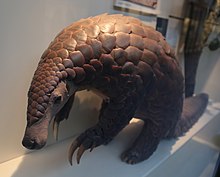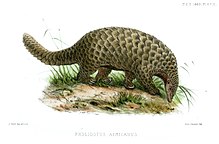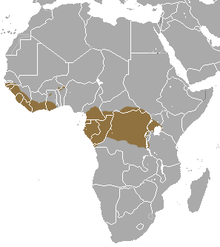| Giant pangolin | |
|---|---|

| |
| Mounted specimen in the Natural History Museum, London | |

| |
| Illustration by Joseph Wolf | |
| Scientific classification | |
| Domain: | Eukaryota |
| Kingdom: | Animalia |
| Phylum: | Chordata |
| Class: | Mammalia |
| Order: | Pholidota |
| Family: | Manidae |
| Genus: | Smutsia |
| Species: | S. gigantea
|
| Binomial name | |
| Smutsia gigantea | |

| |
range
| |
| Synonyms | |
The giant pangolin (Smutsia gigantea) is a species of pangolin from genus Smutsia of subfamily Smutsiinae within the family Manidae. It is the largest living species of pangolins.[7][8][9] Members of the species inhabit Africa with a range stretching along the equator from West Africa to Uganda. It subsists almost entirely on ants and termites.
- ^ Timothy J. Gaudin (2010.) "Pholidota". In Lars Werdelin and William Joseph Sanders (eds.) "Cenozoic Mammals of Africa". University of California Press, Berkeley, London, New York, pp. 599-602
- ^ a b Nixon, S.; Pietersen, D.; Challender, D.; Hoffmann, M.; Godwill Ichu, I.; Bruce, T.; Ingram, D. J.; Matthews, N. & Shirley, M. H. (2019). "Smutsia gigantea". IUCN Red List of Threatened Species. 2019: e.T12762A123584478. doi:10.2305/IUCN.UK.2019-3.RLTS.T12762A123584478.en. Retrieved 17 January 2022.
- ^ Illiger, C. (1815). "Überblick der Säugethiere nach ihrer Verteilung über die Welttheile". Abhandlungen der Königlichen Preußischen Akademie der Wissenschaften zu Berlin. 1804−1811: 39−159. Archived from the original on 2019-06-08. Retrieved 2023-06-04.
- ^ Fitzinger, L. J. (1872.) "Die naturliche familie der schuppenthiere (Manes)." Sitzungsberichte der Kaiserlichen Akademie der Wissenschaften. Mathematisch-Naturwissenschaftliche Classe, CI., LXV, Abth. I, 9-83.
- ^ Grubb, P., Jones, T. S., Davies, A. G., Edberg, E., Starin, E. D., Hill, J. E. (1998.) "Mammals of Ghana, Sierra Leone and the Gambia." Trendrine Press, Zennor, Cornwall.
- ^ Gray, J. E. (1865). "Revision of the genera and species of entomophagous Edentata, founded on the examination of the specimens in the British Museum". Proceedings of the Zoological Society of London: 359–386.
- ^ Schlitter, D.A. (2005). "Order Pholidota". In Wilson, D.E.; Reeder, D.M (eds.). Mammal Species of the World: A Taxonomic and Geographic Reference (3rd ed.). Johns Hopkins University Press. p. 530. ISBN 978-0-8018-8221-0. OCLC 62265494.
- ^ Gaudin, Timothy (2009). "The Phylogeny of Living and Extinct Pangolins (Mammalia, Pholidota) and Associated Taxa: A Morphology Based Analysis" (PDF). Journal of Mammalian Evolution. 16 (4): 235–305. doi:10.1007/s10914-009-9119-9. S2CID 1773698. Archived from the original (PDF) on 25 September 2015. Retrieved 14 May 2015.
- ^ Michael Hoffmann, Stuart Nixon, Daniel Alempijevic, Sam Ayebare, Tom Bruce, Tim R. B. Davenport, John Hart, Terese Hart, Martin Hega, Fiona Maisels, David Mills, Constant Ndjassi (2020), Challender, Daniel W. S.; Nash, Helen C.; Waterman, Carly (eds.), "Chapter 10 - Giant pangolin Smutsia gigantea (Illiger, 1815)", Pangolins, Biodiversity of World: Conservation from Genes to Landscapes, Academic Press, pp. 157–173, doi:10.1016/B978-0-12-815507-3.00010-1, ISBN 978-0-12-815507-3
{{citation}}: CS1 maint: multiple names: authors list (link)
